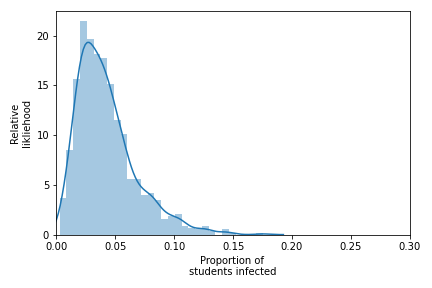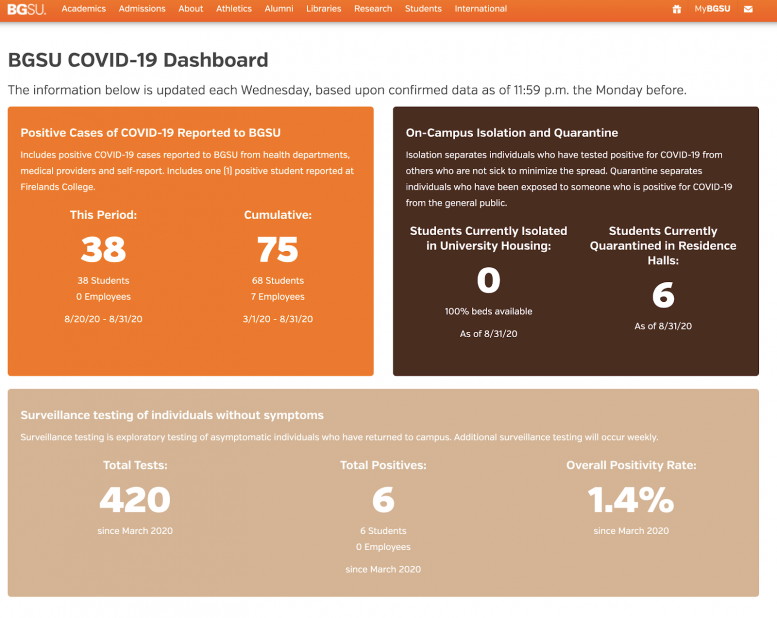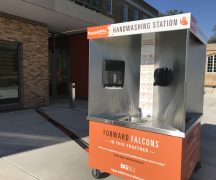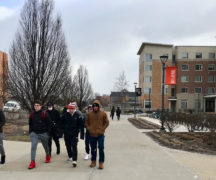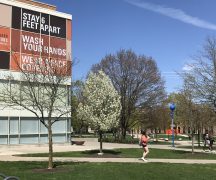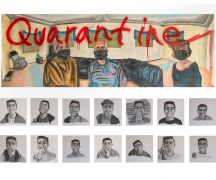Dear Pres. Rogers and CHO Batey,
Pres. Rogers, for years one of your mantras has been that BGSU must make “data-driven decisions.”
BGSU’s own data, taken in the context of epidemiology, reveal BGSU’s testing regime to be a failure, posing deadly risk to BGSU students, staff and faculty, and the Bowling Green community.
Our motivation in writing this letter is to ensure that you are aware, on record, that BGSU’s reported data indicate that there is likely an uncontrolled and unmonitored COVID-19 outbreak among the BGSU student population.
There is widespread scientific consensus about the importance of testing students on entry, as well as the importance of surveillance testing on campus. This is critical because young adults, though unlikely to exhibit COVID-19 symptoms, remain able to transmit the disease. Estimates of the required COVID-19 test frequency range from once every 2-30 days per student (See studies, below our signature). BGSU’s current testing frequency is one test per student every three years.
On August 26, CHO Batey reported that BGSU had conducted a total of 351 tests. Below our signatures is a screenshot of BGSU’s dashboard, through August 31, showing BGSU conducted a total of 420 tests of asymptomatic individuals between March and August 31 (Fig. 1).
That means that BGSU conducted, at most, 69 tests of asymptomatic students from August 26 to August 31. For 13,000 students this works out to one test per student every 1,130 days. That is nowhere near enough to identify, much less contain, an outbreak.
Yet even with such paltry testing, we can see how bad things must be on and off campus. Two of the surveillance tests were positive. We can infer quite a bit from this alone, using Bayesian inference to put bounds on the likely level of infection on campus. A simple analysis suggests that on August 31st, 2.9% of the student population was infected, with a 95% Credible Interval from 1-10% (Fig 2). Please let us know if you would like details of how we arrived at these figures.
It is unclear what population these tests represent, but if it is the 13,000 BGSU students in town then there were likely around 350, but potentially as many as 1,300 undetected cases in Bowling Green on August 31st. Now, a week later, this number is likely to be substantially higher. Our estimate is based on a small, poorly described sample, but ultimately, there is no plausible way to get 2 positive results out of 69 surveillance tests in a week without hundreds of current cases.
BGSU’s reporting only 30 cases is a direct result of BGSU’s insufficient testing protocols. In order to get tested, an infected student must exhibit symptoms, and choose to report them. Only a small portion of infected students are likely to meet these criteria. A sick student being tested is the exception, not the rule. Inadequate testing, not a well executed plan, is the reason campus has only 30 reported cases.
Despite a near total lack of surveillance testing on campus, it is clear that community transmission of coronavirus is likely widespread among the student body. The attack rate—that is, the prevalence of positive tests—appears similar to that of New York City in the second week of March. We fear that, as we write this, the virus will spread outside of the student body to faculty, staff, and community members who will be much more impacted by the disease. We write this letter out of grave concern for the well-being of our colleagues, loved-ones, and those we only know from behind masks on Wooster Street. We worry about the ability of small businesses in BG to survive another shutdown in order to contain an outbreak.
Even with paltry and poorly reported testing, there is sufficient evidence to warrant conducting 2,000 surveillance tests in the next week. If our analysis is flawed in any way, such testing would quickly reveal it while providing useful information. BGSU’s recently announced efforts to ramp up testing in the coming weeks will come too late. Plausible deniability is no longer an option. Failing to dramatically increase surveillance immediately, or to inform the BGSU community of the BGSU’s inability to do so and thus being frank about risks that BGSU’s choices are imposing on students and the Bowling Green community, would be tantamount to negligence.
Opening BGSU’s campus, and doing so to begin classes on August 26, with the current testing regime in place, was a choice. Pres. Rogers and CHO Batey, you have been asked repeatedly, and have not divulged, what, if any, models, data, and assumptions you are relying upon to inform this and other choices, including BGSU’s COVID-19 response.
Lacking transparency concerning BGSU’s testing, we must assume one of the following:
- BGSU is employing a COVID-19 testing regime based upon logic that BGSU leadership is aware diverges significantly from consensus scientific thinking, that it did not divulge to students before they made the decision to come to campus and has still not opened to public scrutiny.
- BGSU leadership is relying on a COVID-19 testing regime that falls within the scientific mainstream, but chose to open campus before implementing that regime in time for it to be effective; further, BGSU leadership chose not to reveal this failure and the risks it posed to students before they made the decision to come to campus, much less to the public; and BGSU continues not to be frank with the public concerning the consequences of this current lack of tests taken and testing capacity.
- BGSU chose to open campus and continues to operate employing a testing regime designed without reference to rigorous models or data, despite the well documented, widely disseminated scientific evidence regarding various testing regimes’ relative costs, risks, and effectiveness.
Simply put, BGSU’s chosen actions have been in conflict both with evidence-based policy and with protecting public health.
Public health demands that BGSU commit to the following actions:
- Immediately cancel all in person events and non-essential facilities until sufficient surveillance testing indicates a reasonably low prevalence of disease.
- Conduct immediate surveillance testing of 2,000 students, faculty and staff located both on and off campus to get a rigorous estimate of prevalence. Joe Bak-Coleman is happy to lend his services,pro bono, to conduct the required analyses.
- Remain in an online-only state until it is possible to test all students, faculty and staff at a frequency consistent with the best available scientific knowledge.
- Make public the date, motivation (surveillance or symptomatic), and outcome for all tests conducted in the past month, and provide that data to the public going forward on a daily basis.
- Make public any models, data, and assumptions BGSU is relying upon to guide its COVID-19 response.
- Describe what, if any, thresholds would prompt shutdown or other possible measures.
- Describe how such a shutdown would be managed to minimize risk to Bowling Green and throughout the state of Ohio.
With the lives of students, staff and faculty, and the wider community at stake, anything less is unacceptable.
We will be sending this email to the Board of Trustees, so that it is a matter of public record at BGSU, as well as to the Mayor and members of City Council of the City of Bowling Green; and to the press.
Andrew Schocket and Joseph Bak-Coleman
Joseph Bak-Coleman, PhD. is a Biologist from Bowling Green, Ohio. He earned his B.S. in Neuroscience and M.S. in Biology at BGSU, and went on to earn his Ph.D. in Ecology and Evolutionary Biology from Princeton University. He is currently employed as a Postdoctoral Scholar at the University of Washington.
Andrew M. Schocket is a Professor of History and American Culture Studies at BGSU; he and his family have lived in the City of Bowling Green since 2001.
Studies of effective frequency of on-campus COVID-19 testing: “Simulating COVID-19 in a University Environment,” pre-published in July, indicated that for a college to be successful, “members of the community will be tested approximately once per month.” A study published on JAMA Network, “Assessment of SARS-CoV-2 Screening Strategies to Permit the Safe Reopening of College Campuses in the United States,” argued that colleges would need to test every two days, while a reply to the article suggested that, should students comply strictly with social distancing, mask-wearing, and the like, institutions could test every four weeks and still contain the spread of the virus. A study of small colleges contended that one test per student per seven days was necessary.
